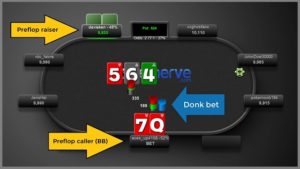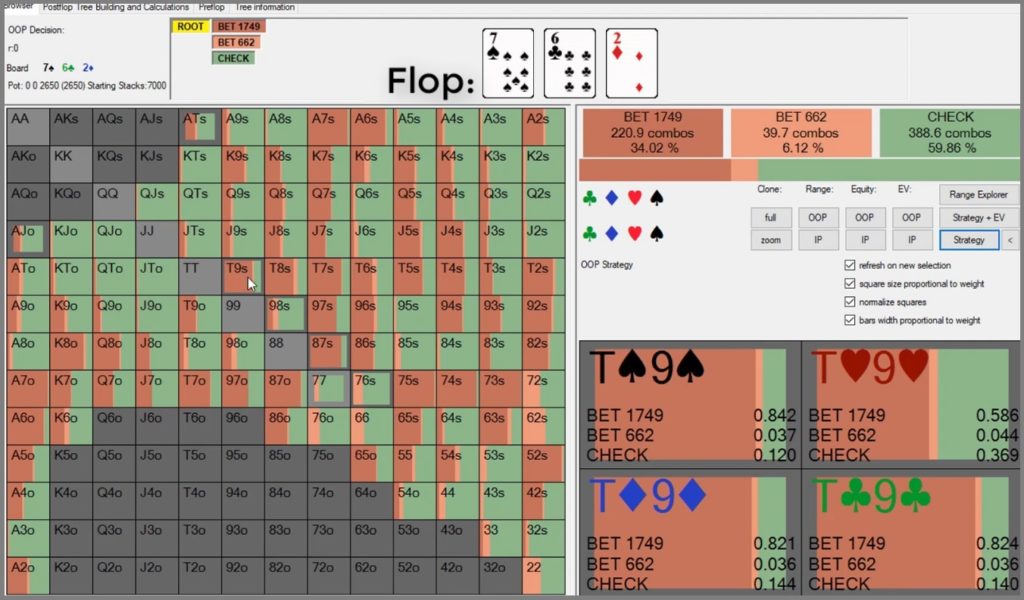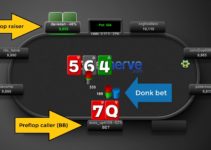In this donk betting strategy sequel we’ll explore flop textures that are great to donk bet on, as well as delve further into the best hand types and bet sizes to use.
Furthermore, I’ll also discuss how to correctly adjust your donk betting strategy according to your stack size.
This will give readers a better understanding of when and how to donk bet, allowing them to implement a more well-rounded and profitable strategy at the table.
Frequently Donk Bet Flops You Should Look Out For
In our previous donk betting article, which you can find here ‘Learning How to Donk Bet’, research and PIOSolver analysis allowed us to determine donk betting is an exceptionally useful strategic option that you can use to improve your win-rate.
 Initially, we discussed applying the important concepts of nut and range advantage, which led to identifying 6-high and 7-high boards as the best flops to donk bet on. This was due to how these lower connected boards favor an OOP (out-of-position) big blind player’s range, providing them with a nut advantage.
Initially, we discussed applying the important concepts of nut and range advantage, which led to identifying 6-high and 7-high boards as the best flops to donk bet on. This was due to how these lower connected boards favor an OOP (out-of-position) big blind player’s range, providing them with a nut advantage.
If you're unfamiliar with what a big blind defending range should look like in various spots or unsure of a good big blind strategy in general, be sure to check out our big blind strategy article.
There're a variety of flop textures that can be great to donk bet on but before we analyze those, let’s do a little more analysis on the important high-frequency donk bet flop types. After all, this is where the majority of our donk betting confrontations will occur, either as the bettor or potentially after being donk bet into. Thus, proceeding confidently in these spots is a must for any poker player trying to improve their game and win more money.
Get it Right with the Correct Donk Bet Size and Frequency
| Flop | Donk 67% pot | Donk 25% pot | Check | Equity | Equity realisation | Expected value |
|---|---|---|---|---|---|---|
| 632r | 48% | 3% | 49% | 48% | 102% | 49 bb |
| 654r | 12% | 55% | 33% | 51% | 107% | 54 bb |
| 753r | 41% | 13% | 47% | 49% | 102% | 50 bb |
| 765 | 10% | 60% | 29% | 50% | 106% | 53 bb |
In order to better understand how the flop texture affects betting frequency as well as the size to bet, let’s compare a GTO approach across some different flop textures varying in their degree of connectivity. In particular, notice the betting patterns using the ¼ and 2/3 bet sizes (that we surmised were very effective sizes in our previous donk betting article).
We can see from the table above, 4-5-6 and 5-6-7-boards are donk bet around 70% of the time, mostly using the smaller size. Moreover, as flops get more disconnected, we want to be donk betting a little less and switch to the bigger size. This is due to the fewer straight combinations resulting in a proportionally reduced number of strong combinations the OOP player can have.
For example, on a 5-6-7 flop, the OOP player can leverage their strong nut advantage due to the numerous straight possibilities (as well as sets, two pairs, and strong draws), allowing them to virtually bet with impunity. This allows the OOP player to also mix in some weaker made hands for thin value or draws that could seek to deny equity.
Overall, the result of this approach is more of a merged betting range, which is somewhat dissimilar to the strategy a solver uses on a 3-5-7 flop.
 On more disconnected textures with less straight potential, the OOP player’s strong holdings are more limited and the overall range, therefore, more susceptible to aggression from the IP player who still holds a range advantage (mostly due to holding the best over pairs which OOP's range is short on since they didn't reraise pre-flop). This forces the OOP player to be more selective with their bets, incentivizing them to bet less and use a more polarized range.
On more disconnected textures with less straight potential, the OOP player’s strong holdings are more limited and the overall range, therefore, more susceptible to aggression from the IP player who still holds a range advantage (mostly due to holding the best over pairs which OOP's range is short on since they didn't reraise pre-flop). This forces the OOP player to be more selective with their bets, incentivizing them to bet less and use a more polarized range.
By recognizing this important strategic concept that commonly occurs in the game of poker, players will be well equipped to make the most of donk betting opportunities.
It’s unrealistic to memorize all the specific patterns generated from a GTO solver. So following the gist of the ‘why’ behind solvers logic, provides a strong practical approach that’s consistent and replicable. This allows you to formulate strong winning strategies that are mindful of GTO play.
This is, of course, often the reason why solvers are used with their takeaways being so important for improving one’s approach to the game (here's an article titled 'Should I Use a Program Like PioSolver in 2021' for those who want to learn more the use of solvers in the game of poker).
The type of player you're playing against is also an important factor to keep in mind, as we covered in the preceding donk betting article. Making the correct adjustments to exploit opponent weaknesses is still a catalyst for beating the game. Here's an example with me putting all of this together to analyze a spot where donk betting is a viable option.
Hopefully, the examples above helped to reinforce what we have discussed so far in regards to donk betting as well as highlight some adjustments you might need to make to your game if you are still fairly new to donk betting (note if you want to practice your play using the software shown throughout the videos in this article, you can head over to one of our partners Simple GTO Trainer and get a 10% discount using this link; Simple GTO Trainer).
Although we saw donk betting was a highly used option by PIOSolver, be mindful of how incorporating a donk betting strategy may impact your regular strategy at the table, especially check-raising and turn lead betting.
Paying attention to how PIOSolver splits its range and the sorts of frequencies it uses help with this. Be selective with the hands you elect to donk bet with to avoid playing a 'face-up' style and thus being vulnerable to counters. In other words, stay balanced by incorporating a mixed strategy rather than always doing the same thing with the same hand type.
This might seem difficult at first, but practice makes perfect. For those that would like to do a little extra practice, using a simulator like Simple GTO Trainer (as used in the videos in this article) can be useful as it allows you to simulate situations over and over. For those interested in this option, you can check it out here and receive a 10% discount.
Position and Range Factors You Should Consider
In the video above you would have noticed around a 33% donk bet frequency being used by PIOSolver, despite the board being highly connected. In this instance, this is due to the board being two-tone as well as the fact the opponent raised from the cutoff. Later position openers have a wider spread of hands which provide more connectivity with lower connected boards.
This mitigates the big blind player's nut advantage since the IP player can also be holding nutty hands, unlike a UTG opener who will be more devoid of very strong holdings on low boards. A good donk betting strategy takes this into account and adjusts by donk betting less relative to the position of the opener around the table.
It's important to remember this cardinal rule as even strong players sometimes break it. Although it's possible in the following video pro 'LLinusLove' is making an exploitative adjustment, his choice to donk bet is highly questionable and highlights the importance of considering what your opponent's range looks like.
Stack Size Adjustments
We've mentioned flop texture, player type, and positional adjustments but stack size adjustments are arguably the most crucial. Naturally, shorter stacks allow for greater leverage in the hand. For example, a small bet may typically not get much credit but if you are short-stacked and therefore approaching what your opponent perceives to be a commitment to the hand threshold, it may alter their response.
By the same token, you don't want to be committing a significant portion of your stack to where the pot odds become so great that you end up being forced to commit in a very marginal situation. This makes the art of bet-sizing crucial for maximum gains when you're short-stacked. To help drive home this important concept, here's a video where I compare the same situation with stack sizes of 20bb and 400bb. Let's observe the shift in the GTO strategy used by PIOSolver.
The video above demonstrates four crucial factors when it comes to profitably donk betting with a short-stack;
- Simply betting to protect our equity when we have a vulnerable yet likely 'best' holding, is often the way to go.
- Frequently betting a large size with these vulnerable hands negates the OOP disadvantage and makes our decision easy.
- Working-in small bets with a more polarized range is a good option as it could lead to an opponent folding away too much equity when they give up, or, ultimately committing to the pot when they are in bad shape.
- Checking is often the most frequently used action so it isn't about always donk betting, but rather, donk betting to the point where checking doesn't signal the strength of your hand. So maintain balance unless you're taking an exploitative route.
Hand Selection When Donk Betting to Play Like a Pro
In the video above, we saw 9♦ T♦ being bet around 80% of the time on a 7♠ 6♣ 2♦ flop when short stacked. Hopefully, this type of efficient bluff stands out as a logical choice for most people. If not, be sure to check out one of our previous articles on semi-bluffing here.
In a nutshell, an efficient bluff is a bet that generates a significant amount of fold equity from a hand that is extremely unlikely to be winning on the current street but does have some chance to become a strong holding.
The aforementioned 9♦ T♦ fits this description well. Firstly, ten high is rarely going to be the best hand at showdown. Secondly, the larger bet used puts the opponent in a difficult spot and in fact did force the IP player to relinquish their equity and fold a better hand. Finally, had we been called by a strong hand, 9♦ T♦ had a gutshot to the nuts as well as the chance to make a back-door flush (of course sometimes a nine or ten could give us the winning hand too, depending on our opponent's holding).

It's these types of efficient bluffs that you should be looking out for, especially when it comes to donk betting. So go ahead and lead with a lot of draws, as well as some made hands for balance.
Another pattern to notice is GTO solvers often use smaller 'jab' bets with very strong hands or trash hands. Although these bets appear quite 'cheap' to call, with a short effective stack size in play they still pose a challenging situation for an IP opponent. That is, continuing in the hand may lead to them over-committing without the required equity, or alternatively folding could result in them giving up on too much equity.
With deeper stacks, you can look to incorporate a more merged selection of hands into your donk betting range. This is particularly the case on heavily connected boards that are a good fit for a big blind player's range. It's hard for an opponent to get overly aggressive in these spots since providing you use the right frequencies, they'll sometimes be running into the nuts or a very strong hand that has them crushed. So you can leverage this fact to your advantage with some crafty donk bets.
Just keep in mind that checking is still frequently used and is a good option. Especially as the flop gets more disconnected, dissolving the OOP player's nut advantage. Having said that, there are still other board textures where introducing a donk bet into your arsenal can improve your results. Let's take a look at a few more of these textures now.
Other Flops Where Donk Betting Can be a Good Strategy
Although 6-high and 7-high connected flops are ideal for donk betting, there are a variety of other flop textures where working in a donk bet can improve your overall EV and make you more difficult to play against. Here's a breakdown of other flop textures where it can make sense to use a donk betting strategy, given the way these flops interact with a tighter openers range and looser big blind defenders range.
Medium Frequency: 8/7/6/5-high flops with high connectivity, and low paired boards such as 6-5-5 or 7-5-5.
Low Frequency: 8/7/6/5-high flops with less connectivity, 9-high, 4-high, and paired flops where the pair is ≤ 9, A-x-x flops mostly where the x-x makes a wheel straight possible.
Here's a video with some donk betting analysis on these flop textures. Along with some discussion on range-vs-range interaction, stack size and player adjustments are also discussed to give you a better understanding of how to approach these less frequently donk bet spots.
Notice in the video above the selection of hands (higher backdoor straight and flush cards) that often make good donk betting candidates. By using the right selection of hands, you give yourself a good chance of improving on later streets as well as ensuring you don't start donk betting too frequently. Although one time to note when we can donk bet at an ultra-high frequency is when we can use an ICM dynamic to our advantage.
What you Need to Know About ICM's Impact on Donk Betting
ICM always greatly influences the play of hands and donk betting is no exception. Whilst it's hard to formulate a specific degree to adjust that can be applied to any situation given the complicated nature of ICM, we can get a good sense of how to adjust by using our own intuition supported by GTO solver findings. This will have us playing better than the competition in these important confrontations.
First and foremost, refrain from using a donk bet in situations with a high-risk premium. This is especially true when facing off against a big stack. The traditional 'bully principle' still applies so tread carefully when in a pot with a big stack who can assert ICM pressure.
On the flip side of the coin, when we have a big stack and the remaining player's stack distribution is such that the shorter stacks have high bubble factors, donk betting is an excellent action to abuse. It's particularly powerful as it prevents the life-saving check-back players under ICM stress are likely to utilize to control the size of the pot enabling them to get to show-down.
When you're in a scenario where you can assert pressure, having a donk bet in your arsenal allows you to take more flops. You can call more from the big blind and then follow up with a donk bet on the favorable flop textures for your range. Here's a short video about using the donk bet when ICM is a factor.
When ICM becomes significant, the video above illustrates how donk betting can be an extra technique you can use to gain an edge. Moderately donk bet spots can become super high-frequency bets due to the amount of ICM pressure that can be applied. Just keep in mind some of the general rules of thumb when it comes to ICM and how that may affect donk betting;
- Players adjusting correctly will be opening (RFI) much tighter when they have a substantial bubble factor
- The benefit of aggressively donk betting is opponent dependant. If your opponent is a maniac tone it down.
- Amplify your donk betting accordingly to how significant the ICM is. If there're large pay jumps and very shorts stacks remaining you may have a chance to really turn up the heat, taking down more pots and dominating the end of a tournament!
Quick Tips for PKO Players
It's worth quickly mentioning another great time to prescribe a donk bet - in PKO tournaments! Utilizing the donk bet in PKO tournaments is a great way to leverage your stack in order to capture more bounties. This is especially true when playing against more passive opponents as donk betting encourages pot growth. As a result, players will be more likely to commit to the pot on the flop or later streets.
So when a player has a 'covering stack' naturally we see GTO solvers up the aggression which translates to more donk betting. For more on PKO strategy, check out our 'Covering Stack Play' or 'Bounty Hunting' PKO strategy guides.
Conclusion
A proficient donk bettor starts off by identifying the right boards that favor the big blind player's range. Whilst 4-5-6 and 5-6-7 boards are the ultimate donk betting flops, low boards with some connectivity and paired flops make good candidates.
Although these boards aren't numerous in terms of combinations, when they do flop, having knowledge of donk betting gives you the upper hand. Just keep in mind checking is still the main play most of the time but by mixing in some donk bets with the right selection of hands you'll be taking a more profitable approach to the game long-term.
On the more ideal flops, we can leverage a considerable nut advantage and bet a more merged range, meaning a high bet frequency using a small bet size. Alternatively, on the lower frequency donk bet flop textures, often opting to use a larger bet size using a more polarized range is a good strategy.
Keep in mind when a player raises is an earlier position, their tighter range will often make it harder for them to contest the pot on flops favorable for the big blind. On the other hand, later position openers won't always have this problem since their range will often include lower combinations of hands that can hit even low connected boards hard. This results in us being less incentivized to donk bet on the 'typical' favorable low boards.
 Having said that, if ICM is a factor, at times donk betting even at 100% can be a good play. This occurs when players are particularly susceptible to ICM pressure and are facing off against a big stack on an unfavorable board for their range. In confrontations like this, knowing your opponent is super helpful. Whilst donk betting at a very high frequency can be a great tactic, against a maniac, the likelihood of an aggressive confrontation may be to the detriment of both the players in the hand.
Having said that, if ICM is a factor, at times donk betting even at 100% can be a good play. This occurs when players are particularly susceptible to ICM pressure and are facing off against a big stack on an unfavorable board for their range. In confrontations like this, knowing your opponent is super helpful. Whilst donk betting at a very high frequency can be a great tactic, against a maniac, the likelihood of an aggressive confrontation may be to the detriment of both the players in the hand.
One last important consideration to reiterate when it comes to donk betting is to shift your bet sizing according to the size of your stack. When shorter stacked, we can commit to the pot with a wider range and often do so using a large donk bet to simplify the process. When we do bet smaller, it will often be with stronger hands or very weak hands so we don't complicate the issue of pot odds in these lower SPR confrontations.
Overall, donk betting heading into 2021 is still massively underutilized. Using this weapon proficiently puts you ahead of the curve, provides greater maneuverability and allows you to take down more pots. Now that's winning poker! So good luck upping your donk betting frequency in upcoming sessions!
Finally, for those who feel they'd like to spend a bit more time honing this critical skill, be sure to check out our Road to Success Course. This course includes a series of videos on donk betting and covers everything you could ever want to know about this important bet type.
This concludes our donk betting strategy series, we hope you enjoyed it. Good luck on the felt!

